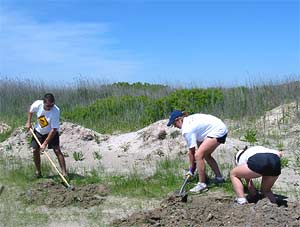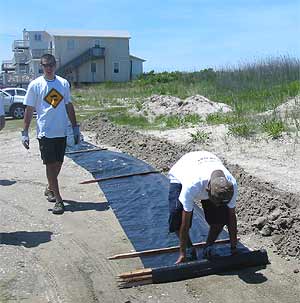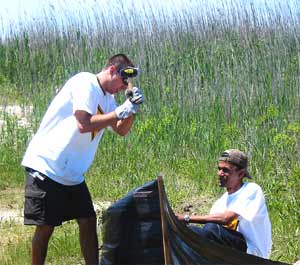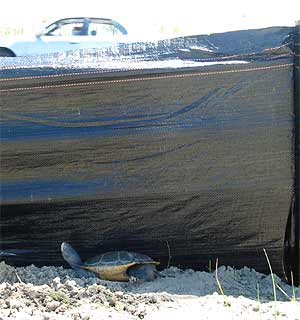|
 |


James, Claire, and Melissa dig trenches.



James and Reza roll out the silt fence...



and they pound stakes.



Diamondback terrapin nests near fence.

|
|
In The Trenches…

By Ben Atkinson
In early June my fellow student researchers and I spent several days digging trenches,* rolling out silt fencing, and pounding stakes to construct a barrier fence along Landis Avenue in Sea Isle City, NJ. My colleagues and I have been swinging sledgehammers, dripping sweat, scratching poison ivy, and pulling ticks . . . but the sense of camaraderie outweighs any unpleasantness.
The stretch of road that our fence parallels is unusual in that it has a salt marsh on one side (habitat of diamondback terrapins), and sand dunes—terrapin nesting habitat (fronting the ocean) on the other. The dunes block the view of the beach from the marsh side. During the annual nesting season (typically late May or early June through mid-July), female terrapins lumber out of their brackish water environment onto dry land. They are heading for high ground, to dig nests and lay eggs above the high tide line—frequently in the dunes across the road.
Unfortunately, the road between the marsh and the dunes is heavily trafficked during the terrapin nesting season. This stretch of road is normally pretty dead during other times of the year, but there is a heavy influx of vacationers between Memorial Day and Labor Day. The local residents are very sympathetic to the plight of the terrapins, but sadly the tourists are all too often uninformed. The barrier fence is mainly along an undeveloped quarter-mile section of land owned by the city. It is also one of the most notorious areas on our road patrol route for roadkills.
Our hope is to deter the females from ever reaching the road, since suitable sandy habitat occurs on the salt marsh side of the enclosure. We already observed one female march up in the middle of our workday, and indeed the barrier did its job. She began nesting on the marsh side of the fence, right in front of us, carapace shining in the sun. Eventually, we will be able to compare 15 years of previous data to this year’s data to determine the project’s effectiveness.


* Part of the process of creating a silt fence is trenching the line the fence will follow, and then burying the base of the fencing material to inhibit turtles from crawling (or digging) under the barrier.
|